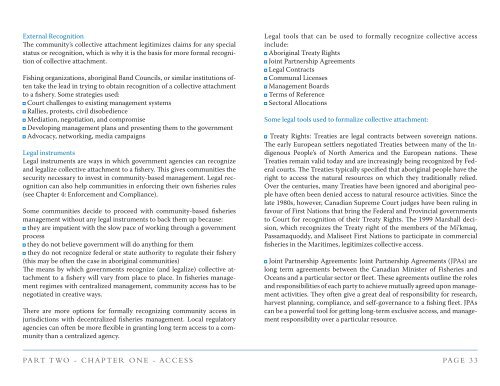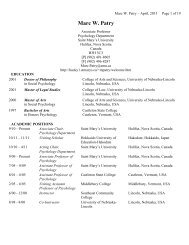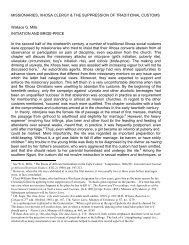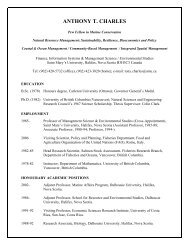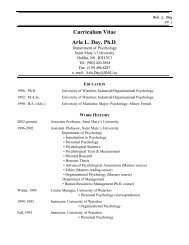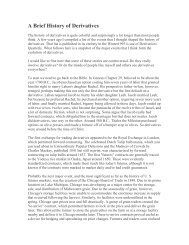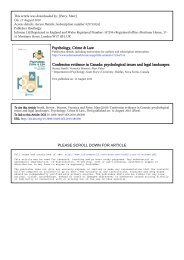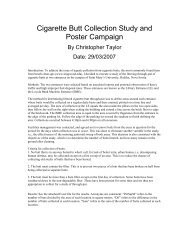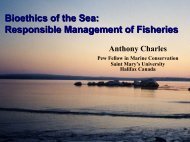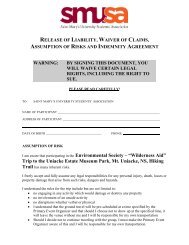Community Fisheries Management Handbook - Saint Mary's University
Community Fisheries Management Handbook - Saint Mary's University
Community Fisheries Management Handbook - Saint Mary's University
You also want an ePaper? Increase the reach of your titles
YUMPU automatically turns print PDFs into web optimized ePapers that Google loves.
External Recognition<br />
The community’s collective attachment legitimizes claims for any special<br />
status or recognition, which is why it is the basis for more formal recognition<br />
of collective attachment.<br />
Fishing organizations, aboriginal Band Councils, or similar institutions often<br />
take the lead in trying to obtain recognition of a collective attachment<br />
to a fishery. Some strategies used:<br />
Court challenges to existing management systems<br />
Rallies, protests, civil disobedience<br />
Mediation, negotiation, and compromise<br />
Developing management plans and presenting them to the government<br />
Advocacy, networking, media campaigns<br />
Legal instruments<br />
Legal instruments are ways in which government agencies can recognize<br />
and legalize collective attachment to a fishery. This gives communities the<br />
security necessary to invest in community-based management. Legal recognition<br />
can also help communities in enforcing their own fisheries rules<br />
(see Chapter 4: Enforcement and Compliance).<br />
Some communities decide to proceed with community-based fisheries<br />
management without any legal instruments to back them up because:<br />
they are impatient with the slow pace of working through a government<br />
process<br />
they do not believe government will do anything for them<br />
they do not recognize federal or state authority to regulate their fishery<br />
(this may be often the case in aboriginal communities)<br />
The means by which governments recognize (and legalize) collective attachment<br />
to a fishery will vary from place to place. In fisheries management<br />
regimes with centralized management, community access has to be<br />
negotiated in creative ways.<br />
There are more options for formally recognizing community access in<br />
jurisdictions with decentralized fisheries management. Local regulatory<br />
agencies can often be more flexible in granting long term access to a community<br />
than a centralized agency.<br />
Legal tools that can be used to formally recognize collective access<br />
include:<br />
Aboriginal Treaty Rights<br />
Joint Partnership Agreements<br />
Legal Contracts<br />
Communal Licenses<br />
<strong>Management</strong> Boards<br />
Terms of Reference<br />
Sectoral Allocations<br />
Some legal tools used to formalize collective attachment:<br />
Treaty Rights: Treaties are legal contracts between sovereign nations.<br />
The early European settlers negotiated Treaties between many of the Indigenous<br />
People’s of North America and the European nations. These<br />
Treaties remain valid today and are increasingly being recognized by Federal<br />
courts. The Treaties typically specified that aboriginal people have the<br />
right to access the natural resources on which they traditionally relied.<br />
Over the centuries, many Treaties have been ignored and aboriginal people<br />
have often been denied access to natural resource activities. Since the<br />
late 1980s, however, Canadian Supreme Court judges have been ruling in<br />
favour of First Nations that bring the Federal and Provincial governments<br />
to Court for recognition of their Treaty Rights. The 1999 Marshall decision,<br />
which recognizes the Treaty right of the members of the Mi’kmaq,<br />
Passamaquoddy, and Maliseet First Nations to participate in commercial<br />
fisheries in the Maritimes, legitimizes collective access.<br />
Joint Partnership Agreements: Joint Partnership Agreements (JPAs) are<br />
long term agreements between the Canadian Minister of <strong>Fisheries</strong> and<br />
Oceans and a particular sector or fleet. These agreements outline the roles<br />
and responsibilities of each party to achieve mutually agreed upon management<br />
activities. They often give a great deal of responsibility for research,<br />
harvest planning, compliance, and self-governance to a fishing fleet. JPAs<br />
can be a powerful tool for getting long-term exclusive access, and management<br />
responsibility over a particular resource.<br />
PA RT T WO - C H A P T E R O N E - AC C E S S<br />
PAG E 3 3


